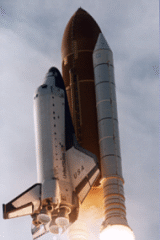
STARSHINE 3 UPDATE - June 22, 2001
|
| And now on to a progress report on our Starshine 3 status. We are moving along nicely toward the scheduled launch date of August 31, 2001. The Naval Research Laboratory's Starshine engineering team is installing 31 laser corner reflectors and a series of triple-junction solar cells and integrated power supplies from the NASA Glenn Research Center on the surface of the Starshine 3 satellite. NASA Glenn will complete vibration testing on Cynetics Corporation's telemetry transmitter at the end of this week. After final software testing at the South Dakota School of Mines and Technology, the transmitter and control electronics box will be installed on the payload deck inside the spacecraft on July 5. |
|
all the children in the world during the
satellite's four-year lifetime.
The satellite will be deployed from the launch vehicle by a Lightband system being built by Planetary Systems Corporation in Silver Springs, MD. After certifying this deployment system on the Kodiak Star mission, we later plan to use it to deploy other Starshine satellites from Space Shuttle orbiters, |
|
The test article used for the fit check and separation test was a
hemispherical mass mockup of the Starshine 3 satellite.
The actual spacecraft is a complete sphere, nearly a meter in diameter (37 inches), that weighs 88 kilograms (193 pounds). It will carry 1500 polished mirrors, 31 laser retroreflectors, and seven clusters of solar cells and button batteries from the NASA Glenn Research Center in Cleveland, OH. The solar cells will power an amateur radio communication system being built by Cynetics Corporation and the South Dakota School of Mines and Technology in Rapid City, SD. The system's transmitter will send out a beacon signal every sixty seconds at a frequency of 145.825 Megahertz to amateur radio operators, or "hams," all over the world. The hams will relay the output of the solar cells to us, so we can determine how the spin rate of the satellite slows down during the satellite's four-year mission. Eddy currents in the aluminum shell, generated by the satellite's passage through the earth's magnetic field, will brake the satellite's spin at a rate that is hard to calculate, so we'll measure that rate throughout the mission. This information will be used in the design of a spin-up and re-spin system for the Starshine 4 and 5 satellites. Speaking of those satellites, we're still hopeful that NASA will be able to fly them on the STS-114 mission to Space Station Alpha in late 2002. We're going ahead and assembling mirror polishing kits for them this summer, hoping that this flight opportunity does indeed develop. However, we won't know about it, for certain, until October of 2001. We'll be accepting applications for Starshine 4 and 5 mirror kits, starting in September of 2001, but we'll hold off mailing the kits until after we get the final word from NASA. For earlier reports on the Starshine 3 satellite, scroll down on this web page to the heading entitled "Page Updates Archive" and click on it. |
STARSHINE 2 UPDATE - June 22, 2001
|
|
The Space Shuttle STS-108 launch, with our Starshine 2 satellite aboard, has been postponed until November 29, 2001. Engineers at the Naval Research Laboratory have completed the installation of 845 student-polished mirrors, 31 laser retrorefectors and 2 micro-jet thrusters on the surface of the Starshine 2 satellite shell in a clean room at their satellite assembly facility. They have also completed the construction and assembly of a pressure vessel and valve that will work with the micro-jet thrusters to spin Starshine 2 at the start of its orbital mission. Schools in the vicinity of the Naval Research Laboratory in southeast Washington, DC can make arrangements to visit the laboratory and watch their mirrors being vibration tested on the Starshine 2 satellite. Due to the aforementioned delay in the launch schedule, this vibration test has been postponed until July 2 and 3. Teachers wishing to schedule a visit to the laboratory should send an email message to Mr. Bill Braun, Starshine Spacecraft Program Manager, at braun@space.nrl.navy.mil or call him at 202-767-0695. |
 |
| The satellite will be delivered to the NASA Goddard Space Flight Center in Greenbelt, MD on July 9. Schools in the vicinity of the Goddard center can make arrangements to observe the satellite being integrated into its Hitchhiker canister sometime during the period July 12-18. To do so, please call Dr. Ruthan Lewis, MACH-1 Mission Manager, at 301-286-0818 or send her an email at Ruthan.Lewis@gsfc.nasa.gov . |